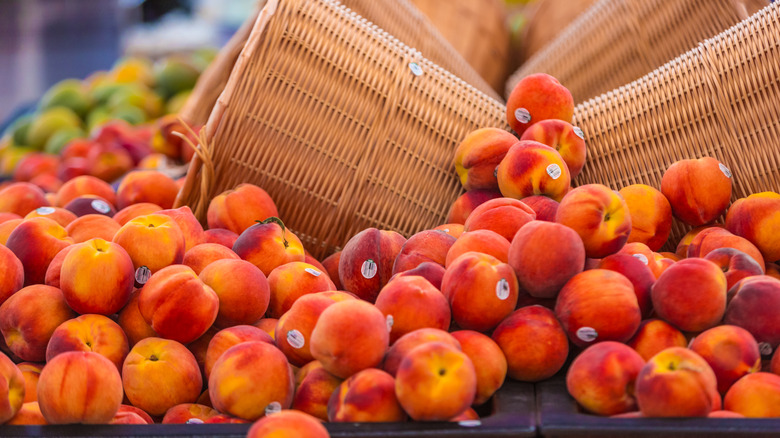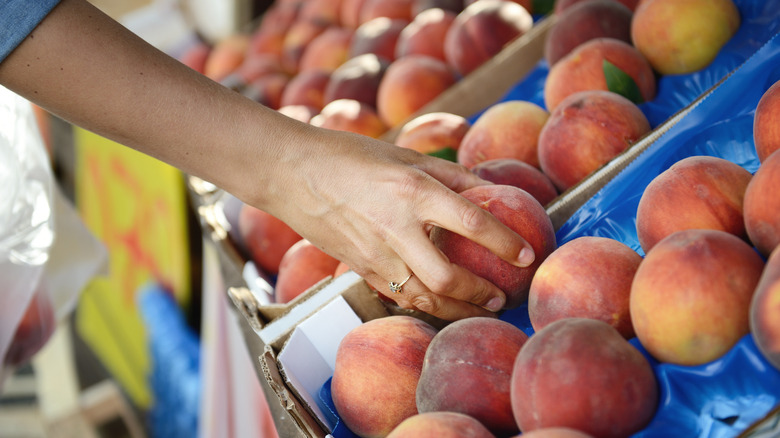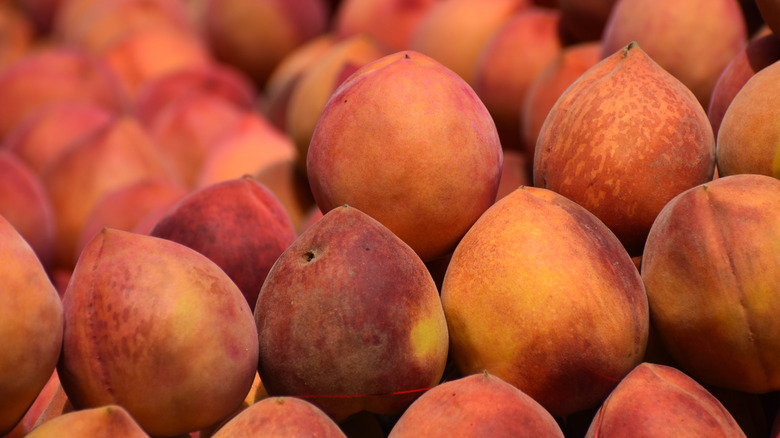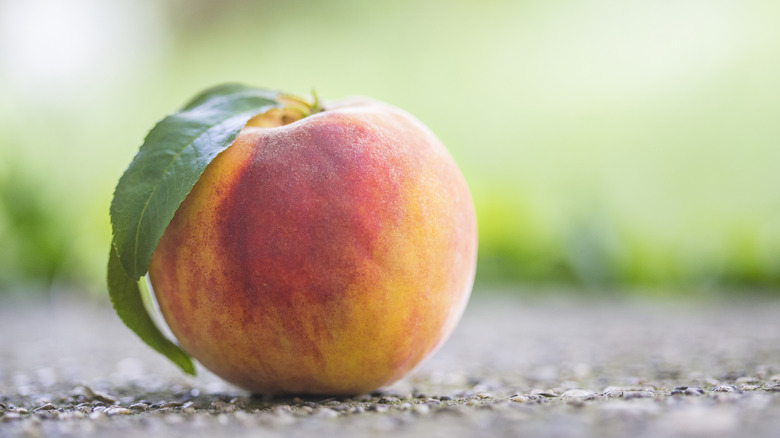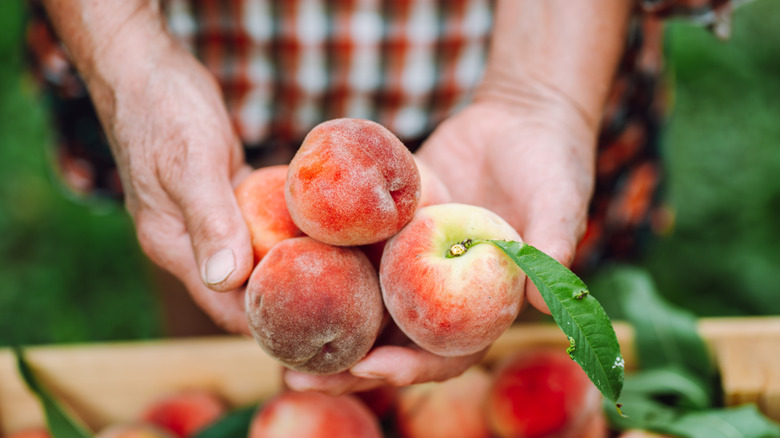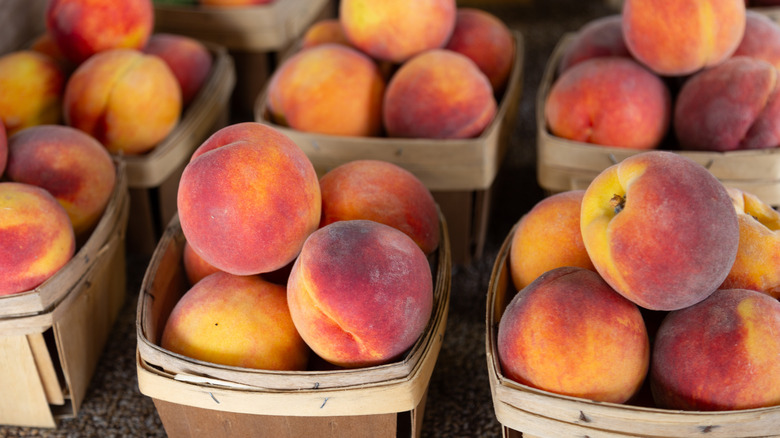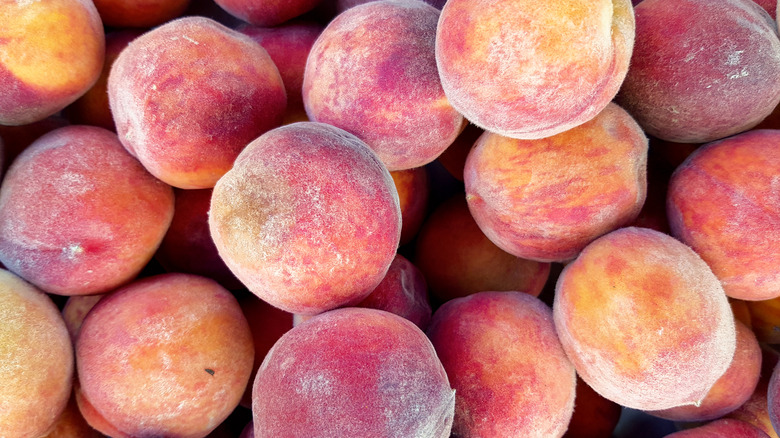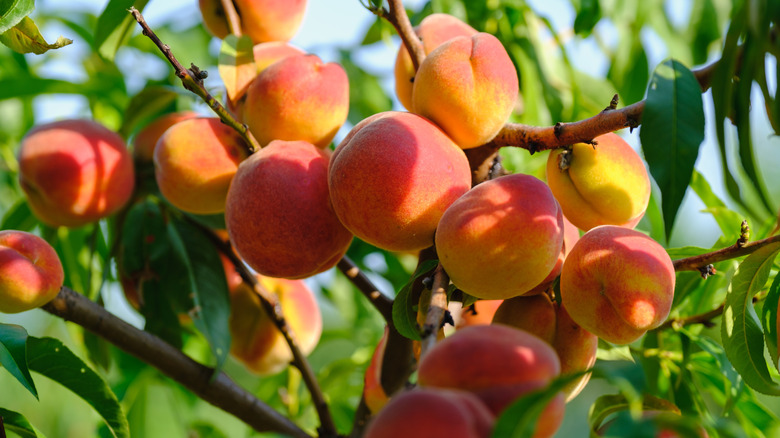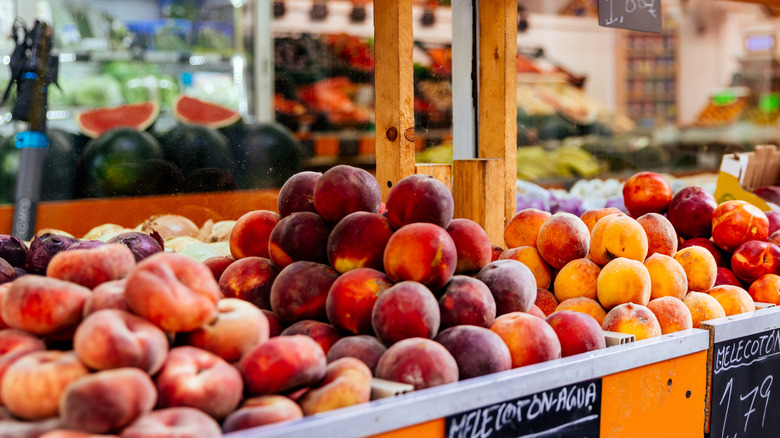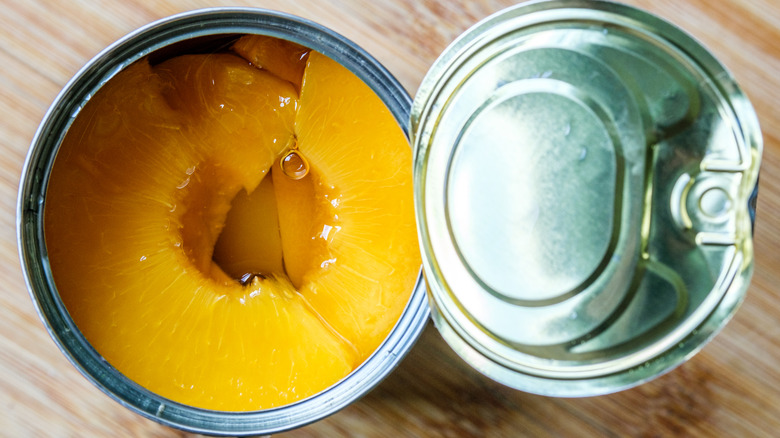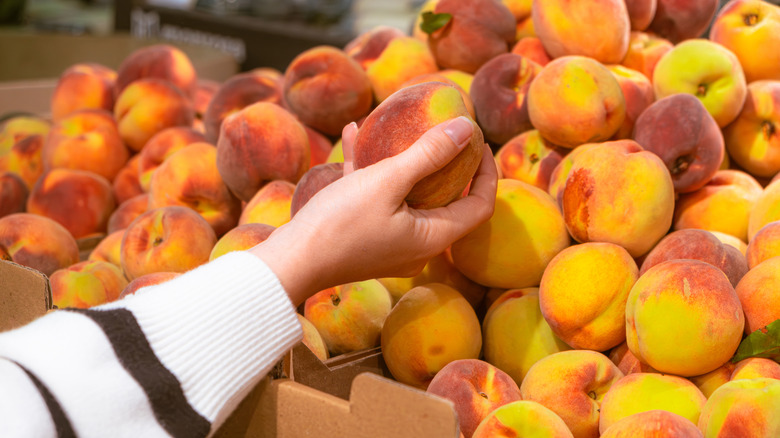Mistakes Everyone Makes When Buying Peaches
As days get longer and hotter, our cravings gravitate more and more around one juicy, golden fruit. Yes, peaches may be the official state fruit of Georgia, but they're basically the unofficial fruit of the summer. What else matches the guilty pleasure of sneaking a peach out of the grocery bag as soon as you get home, eating like a child over the sink as its juices run down your arm? When we can practice a little restraint, they're also an iconic addition to fruit pies and tarts.
Native to China (where they're also a symbol of good luck and longevity), peach trees blossom in late winter and bear fruit anywhere from late spring to early fall. Peaches are one of many stone fruits — like cherries — that have an unmistakable seed in the pit. Although China has remained the top producer, cultivation has spread worldwide including other major growers like Spain and Turkey. According to the USDA, U.S. peach production totaled over 625,000 tons in 2022, and no matter what the Georgians tell you, California is the country's primary producer.
Peaches offer endless versatility and flavor — from peach cobbler in the air fryer to grilled and served over ice cream — but the trick is choosing a good one. To buy the best peaches (especially fresh ones), you'll need to use your senses, plan ahead, and dodge some common mistakes. Choosing is straightforward, but it's best to not rush the decision. Check out what to avoid below.
You're not giving your peaches a (gentle) squeeze
Have you ever marveled at the shoppers in the produce section who seem to have a superpower for picking the best fruits and veggies? We can hardly fathom the effortless calculations running through their minds, but one of their considerations is probably a lot more tangible. In fact, if you're not giving your peaches a quick squeeze before purchase, you're skipping a simple test for quality.
The skin of a peach at its prime should look and feel taut — as if it's about to burst with fruity goodness. Grab the fruit and use your thumb to lightly press into its shoulders (that rounded area on top). It should feel firm, yet yield slightly under pressure. If you're good at choosing the best avocados at the store, peaches similarly hit their sweet spot when soft but not too soft. You shouldn't press so hard it bruises (then furtively set it back down) — but by concentrating on the shoulders, any accidental bruise should be easier to cut away. At their ideal firmness, you're all set for grilling up those peaches or directly biting into them.
While you've got the peach in hand, pay attention to the skin's texture. That characteristic fuzz is pretty delicate, so if it's really fuzzy, it's a good indicator the fruit is fresher and has gone through less handling and transport. Avoid any with excessively wrinkly skin, as this can signal dehydration, over-ripeness, or an unpleasant texture.
You're fooled by the red blush
Unlike apples — which can be more deceiving with color — a peach wears its heart on its sleeve. When it's ripe, it will show. The stone fruit begins its life as green on the tree, but as it matures, the chlorophyll in its skin breaks down into antioxidants (like carotenoids and red anthocyanins), protecting it from untimely spoiling and changing its color. A ripe peach will flaunt a yellow or orange background color, and as this undertone deepens and becomes more golden, the fruit becomes sweeter and juicier. If you spot a peach with shades of green, it was probably picked prematurely and missed out on the tree's final push of sugar and nutrients.
Where this gets tricky is the red blush. No, the peach isn't being coy, and no, these typical rosy spots aren't a sign of ripeness. Instead, the fruit's red blush just shows where it got more sun during maturation — like an awkward sunburn. If it's starting to sound complicated, you don't need a Master's degree in color theory before choosing a peach. Look around the stem for that vibrant, yellow undertone. This area is shaded by branches and leaves so it won't show any blush, making it the clearest spot to tell if the peach is ready to eat. As for any unsightly nicks or bruises, give those a pass, too. While not all bruises are bad, the blemish will be mushy and taste overripe.
You didn't realize the pit matters
As much as we love them, every peach has its pesky pit we inevitably have to face. If you find yourself struggling to remove the peach pit, you might mistakenly assume you chose an unripe specimen. Peaches have a couple different pit varieties, however, and one proves extra-troublesome to remove even at its prime. Clingstone peaches – the tricky ones — have the pit woven into the flesh and, as the name implies, are a bit clingy. Freestone pits, on the other hand, peel away easily.
You might wonder why anyone would go through the nuisance of buying clingstone varieties, but these peaches are generally smaller, softer, and more juicy. Their freestone counterparts are bigger and a bit firmer. Each type is sweet and delicious, but clingstones make for great jams and juicy snacks. If you're canning or baking with peaches — involving lots of pit extractions — freestones will make your life easier, and they'll maintain their texture better.
Apart from prying open the fruit, you can't really determine the pit type based on appearance. Both varieties come in yellow and white flesh, for example. However, clingstones typically ripen earlier in the season, meaning they'll be the fresh peaches you find in May or June. Freestones are the late bloomers you can buy in August or September. This can also be a great opportunity to frequent the farmer's market, where local vendors will probably know more about their produce than the supermarket.
You skip the stem check
If you're not one to leave things up to chance, you'll need to add the green stem trick to your peach-picking repertoire. In fact, ignoring the stems while you peruse could be preventing you from taking home the ripest peaches for immediate use.
First off, take a look at the top of the fruit. The cleft should be round and well-defined, as opposed to an overripe peach that's losing its shape. Right at the epicenter of the cleft, check for the color of that little ring around the bottom of the stem. If it's brown, that peach is good to go. If it's green, put it back or at least give it some more time to ripen before biting into it. A green-stemmed peach will likely taste stiffer and more tart.
In addition, the stem can give you some clues about the peach's integrity. Peaches that are missing their stems at the farmer's market, for example, could indicate the fruit was picked at peak ripeness and the stem naturally plucked off. After all, the best peaches are those that were left to ripen and sunbathe as long as possible on the tree. Just make sure there are no holes and the skin is sealed up nicely. Supermarket peaches, however, usually travel longer distances and it could be a positive sign if the stem is still in place. This means the stem kept the good stuff in, and excess air, humidity, and critters out.
You forgot to give them a whiff
If you're rummaging through the crate of peaches and are suddenly hit with a warm and sweet aroma, chances are you're in good hands. The rules couldn't be simpler: If it smells like a peach, it will taste like a peach. It would stand to reason then, if your peaches have no aroma, they'll probably have no flavor. Skipping the nose check puts you at risk of taking home sub-par fruit that may never reach its full potential.
Unlike oranges or grapes — fruits that must be picked at peak ripeness — peaches are climacteric fruits, meaning they continue to ripen after harvest. Although this gives us more flexibility over when we pick and eat them, climacteric fruits still need the necessary stockpile of nutrients to smell (and taste) their best. Ethylene is the primary component responsible for ripening, a process that mellows out starches and acids while developing more sugars. If the stone fruit was harvested prematurely, it may not have enough ethylene to later ripen properly.
During ripening, the peach also generates another compound called lactones, an agent that gives many fruits their characteristic fruity and floral fragrances. Using your nose to judge a peach shouldn't even take any time, because a good peach won't let you go without smelling it. The sweeter and more intense the aroma, the riper the peach; almost as if it were shouting, "Eat me, now!"
You're buying out of season
No matter how much you're craving fresh peaches, there is a wrong place and time. U.S. peach season launches in late spring and concludes in early fall, peaking around July and August. If you're buying "fresh" peaches from the produce section in January, something's not right. (You can always use canned peaches for cobbler, anyway.) The best peaches are tree-ripened — left to mature on the tree as long as possible — but off-season fruit is likely picked early, refrigerated, and shipped. This dehydrates the fruit and compromises its flavor. Also, remember that clingstone varieties typically arrive earlier in the season, so if you see freestones advertised in May, it should give you some pause.
While peach trees thrive in warm, dry weather, they also require considerable chill time — temperatures below 45 degrees Fahrenheit — in order to bear the best fruit. This means that peach season varies by region. California harvests its peaches anywhere from April to October, whereas South Carolina and Georgia deliver from May to August. Outliers include balmy Florida, where peaches are only in season from April to May, and cooler Michigan, where the best time is late July to September.
Even if you make all the right seasonal considerations, a supermarket peach may never match the goodness of fresh orchard fruit. Large grocers notoriously import their produce, likely harvesting peaches in varying shades of green. Take the time to find nearby "U-pick" operations or farmer's markets for the most in-season peaches.
You assume bigger is better
Maybe you've always fantasized about having your "James and the Giant Peach" moment, but we're telling you right now that no stone fruit has any business being so big. According to a 2021 Tridge report, about 45% of peaches produced in the U.S. are for fresh produce, while the rest are processed for canning, juicing, drying, etc. You have to consider, most of the fresh-produce peaches are destined for grocery store aisles and are cultivated to look as aesthetic as possible. This can include color, shape, or lack of blemishes, but it especially involves size.
While bigger fruits are eye-catching, we need to shake the misconception that they're inherently better. A peach that is abnormally big (or small, for that matter) can indicate the proportion of sugars and acidity is out of whack. Bigger peaches, for example, require more irrigation while growing, resulting in a watery, less concentrated, flavor. That's not to mention the environmental considerations of using excessive water just for looks.
Ideally, standard white or yellow-flesh peaches should fall somewhere between medium and large. If you prefer specifics, a ripe peach will be about the size of a baseball, and should be almost as round. In fact, peaches continue to grow rounder as they ripen, while the immature fruits are typically longer and more ovular. Weigh your choices side by side, as well. The best peaches feel heavy for their size, a good indicator that they're bursting with more juice.
You don't care where they come from
It turns out that we're not the only ones who love fresh peaches. The soft and sweet fruits attract all kinds of pests and diseases, meaning peach growers typically need to spray trees with pesticides and fungicides. Because insects and infections spread quickly, large-scale orchards are particularly heavy-handed with their sprays, but even smaller, organic operations use pesticides, just under stricter regulations. Environmental Working Group has consistently thrown peaches onto its "Dirty Dozen" report, detailing that 99% of conventionally-grown U.S. peaches presented pesticide contamination. Some samples tested for as many as 19 different types of residue.
Before you renounce peaches forever, the real mistake here is that you're not armed with all the facts to make an informed choice. After all, eating mass-produced fruit is still better than eating no fruit at all. Genetic Literacy Project has even criticized EWG for its ties to the organic industry, and the watch group's vested interest in fear-mongering conventional fruit.
If you buy supermarket peaches because of regional availability or budget considerations, just be sure to give them a good rinse or even peel the skins. Whenever possible, however, try to go for the local or organic peaches. Buying from the farmer's market offers greater transparency and the chance to speak directly to the people picking your peaches. Moreover, the organic label gives you more guarantees that the fruit was grown under strict requirements for both environmental and public health.
You think all peaches are the same
If your snacks and recipes aren't turning out quite how you expected, it may be more of a peach-picking problem than lack of skill. Not only do peaches have different types of pits, but the stone fruit also comes in a world of variety, from size, flesh color, and flavor. The most obvious distinction is yellow versus white-fleshed peaches. Yellow peaches are the most common in the U.S., offering a firmer flesh and a more striking balance of tangy and sweet. Their texture holds up better for baking and canning, while also gifting your pies and cakes with a bright acidity. Don't hold out on eating them raw either, as they offer a tart companion on charcuterie boards, salads, or for smoking up peaches the right way.
White-flesh peaches, however, are sweeter and juicier. They have a lighter yellow skin when ripe, whereas yellow-flesh peaches are orange or even golden. Delicate and prone to falling apart, white-flesh peaches should be avoided for baking, working best in jams, syrups, or raw. The Belle of Georgia is a popular late-season variety that offers the best of both worlds, both big and firm with the sweetness and juiciness of white flesh.
Other varieties you'll encounter include the donut peach, which is small, flat, and white-fleshed, making for a killer sweet treat. Nectarines are also a type of peach, available in both white and yellow flesh, but with a thinner skin that lacks the characteristic fuzz.
Mistaking fresh peaches as always being best
Before you let peach season go to your head, take a minute to plan out your intentions. It may feel sacrilegious to buy canned or frozen peaches during the warmer months, but depending on the recipe, they're certainly more convenient, if not all around better. For starters, you're typically going to pay more for fresh peaches, and maybe the premium price isn't worth it to blend into your morning smoothie. Plus, frozen fruit can make your smoothie thicker and colder.
Also, consider the effort you'd like to invest in kitchen prep. Fresh peaches are messier and more time-consuming — clingstones in particular — when it comes to peeling, pitting, and cutting. Because canned peaches are heat-treated and soaked in syrups, using them for baked goods like muffins or cobblers can speed up the process and make the end result juicier and sweeter (if that's your thing). When substituting in baking, one can of peaches is equivalent to about three fresh.
While nothing quite defines the taste of summer like a fresh peach, buying fresh ultimately restricts us to the warmer months. You don't have to suppress your cravings for peachy salsa or peach ice cream in the winter, but you should avoid the produce aisle where the selection will be less than desirable. Choose frozen peaches and you can usually throw them right from the freezer into your creations. If they need to be thawed, stick them in the fridge for a few hours.
You're buying too many
No matter how many peaches Justin Bieber got down in Georgia, it's possible to have too much of a good thing. As giddy as you might feel when fresh peaches fill up the produce section, remember they're delicate fruits — it's not like stocking up on toilet paper at Costco. Peaches ripen quickly and bruise easily, meaning you might waste precious fruit or find a spoiled specimen at the bottom of the fruit bowl if you don't plan accordingly. Bruised peaches are great if they've been discounted — just slice off the mushy part or use them for baking — but the bruise does release more ethylene. A fruit's natural ripening agent, excess ethylene can weaken the fruit and spread to others if you've bought too many, risking mold growth and over-ripening.
If we can't stop you from stockpiling, at least proceed with common sense. Buy the peaches at varying levels of ripeness, and stick the softer ones in the fridge for more immediate use. The greener ones can be left out on the counter for a few days to ripen. If they're not maturing fast enough, stick them in a brown paper bag with a banana.
Taking home one too many is also a good opportunity to brush up on your canning skills or learn how to freeze peaches. Freezing your fruit locks in all the same nutrients as fresh, but also results in a more concentrated flavor and softer texture when thawed.
